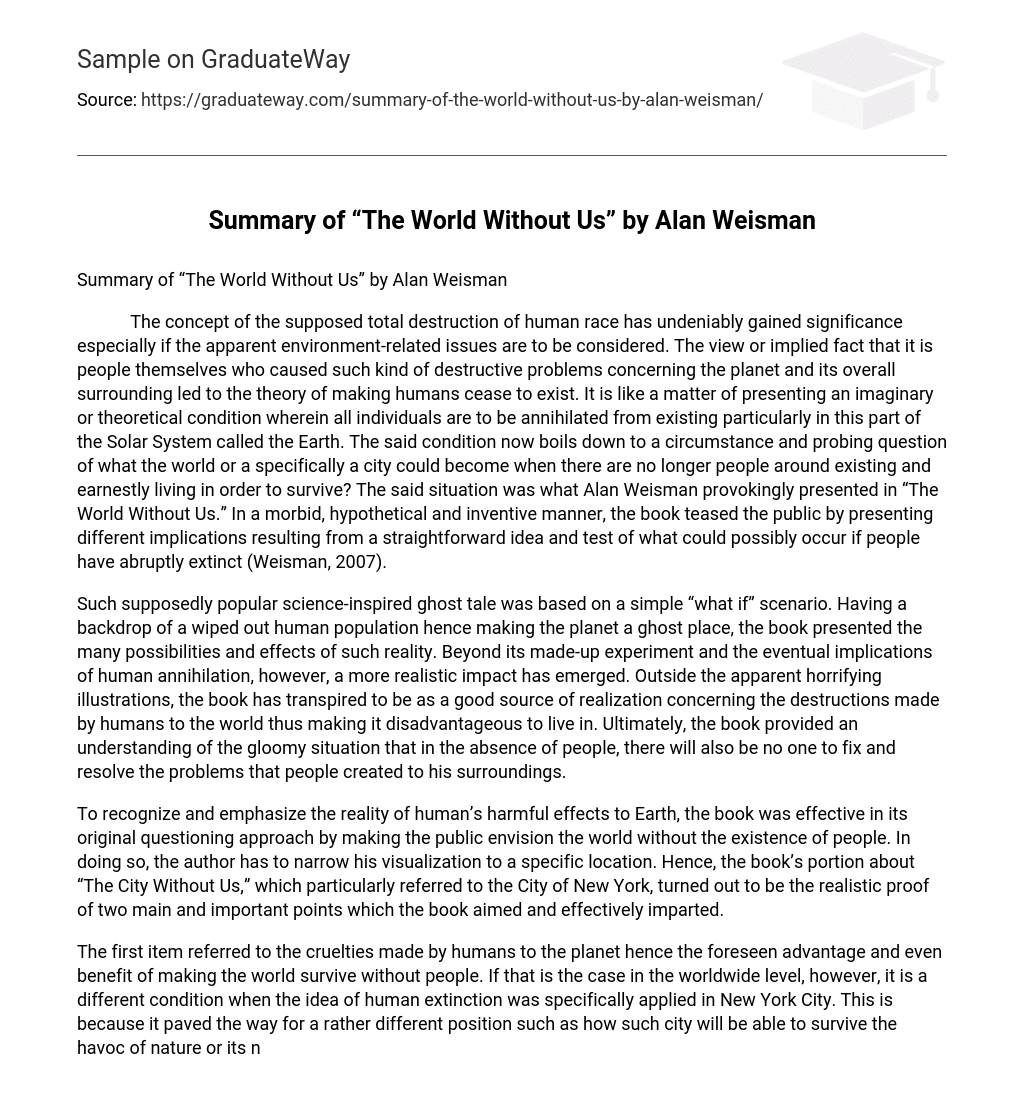The concept of the supposed total destruction of human race has undeniably gained significance especially if the apparent environment-related issues are to be considered. The view or implied fact that it is people themselves who caused such kind of destructive problems concerning the planet and its overall surrounding led to the theory of making humans cease to exist. It is like a matter of presenting an imaginary or theoretical condition wherein all individuals are to be annihilated from existing particularly in this part of the Solar System called the Earth. The said condition now boils down to a circumstance and probing question of what the world or a specifically a city could become when there are no longer people around existing and earnestly living in order to survive? The said situation was what Alan Weisman provokingly presented in “The World Without Us.” In a morbid, hypothetical and inventive manner, the book teased the public by presenting different implications resulting from a straightforward idea and test of what could possibly occur if people have abruptly extinct (Weisman, 2007).
Such supposedly popular science-inspired ghost tale was based on a simple “what if” scenario. Having a backdrop of a wiped out human population hence making the planet a ghost place, the book presented the many possibilities and effects of such reality. Beyond its made-up experiment and the eventual implications of human annihilation, however, a more realistic impact has emerged. Outside the apparent horrifying illustrations, the book has transpired to be as a good source of realization concerning the destructions made by humans to the world thus making it disadvantageous to live in. Ultimately, the book provided an understanding of the gloomy situation that in the absence of people, there will also be no one to fix and resolve the problems that people created to his surroundings.
To recognize and emphasize the reality of human’s harmful effects to Earth, the book was effective in its original questioning approach by making the public envision the world without the existence of people. In doing so, the author has to narrow his visualization to a specific location. Hence, the book’s portion about “The City Without Us,” which particularly referred to the City of New York, turned out to be the realistic proof of two main and important points which the book aimed and effectively imparted.
The first item referred to the cruelties made by humans to the planet hence the foreseen advantage and even benefit of making the world survive without people. If that is the case in the worldwide level, however, it is a different condition when the idea of human extinction was specifically applied in New York City. This is because it paved the way for a rather different position such as how such city will be able to survive the havoc of nature or its natural wear and tear stage in the event or if people no longer exist. Hence, it is notable that the book selected another would-be scenario of what will happen to New York City if it is subjected to many forms of destruction. The readers were provided with a rational insight of the need for people to still exist because a city without us, on the other hand, is definitely not acceptable. This is because there will be no humans, in turn, who will fix or resolve and eventually save the city like New York from its final collapse.
Taking into consideration the expertise and innate qualities of professionals such as engineers and other related specialists and licensed people, the book explicitly depicted how the world will be nowadays without the presence of humans. Particularly comparing a condition of human extinction around the world with absence of people in an advance city like New York, the book effectively cleared out the opposing conditions and instead gave a solution. That is, a world without humans’ destructions is indeed beneficial thus the Earth without people and the dangers they make is naturally advantageous. But with today’s human damages inflicted to a city, it is now disadvantageous that there will be no people to solve the problems. Such contrasting interpretation of the two conditions served to be an influential answer to the problem which, in fact, not required for human extinction.
Reference
Weisman, A. (2007). The World Without US. New York, NY: Thomas Dunne Books.





